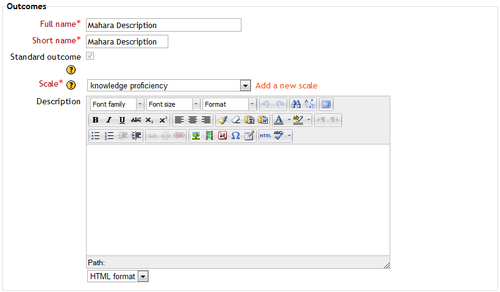If you recall, you have already seen the Outcomes option on the Site Administration tree. That is where we are going now.
- Select the Site Administration tree from the Settings block.
- Click on Grades to expand the options available there.
- Click on Outcomes to enter into the Outcomes management page. Unless you have added some before, this page will just have the button Add a new outcome.
- Click on Add a new outcome. The form has 5 parts. The standard outcome option is locked. All outcomes added through the site administration are standard outcomes. We should fill in the complete form. However, Description is not a required field.
- Type Mahara Description into the Full name field.
- Type Mahara Description into the Short name field.
- For Scale, select knowledge proficiency from the drop-down list. If you have added more options, they will appear here. If you have forgotten to add a scale that you want to use, there is a link here which brings you to that page.
- Ignore the Description field for now as it is not required (you can see required fields shown in red with an asterisk beside them).

- Click on Save changes.
- Repeat steps 4 to 9 to add three more Outcomes: Mahara Benefits, Mahara Pricing, and Mahara USP.
- You will notice that these are displayed in alphabetical order on the Outcomes page. This is also the case when you select them for courses and activities.
We just added in four Outcomes into the Moodle database. These are all graded by the new Scale, which we had entered previously.
You will also notice that these are displayed in alphabetical order on the Outcomes page. This is also the case when you select them for courses and activities.
Adding Outcomes one at a time is pretty straightforward. However, if you have hundreds of Outcomes, this may become a bit tedious and time consuming. There is another way too.
Luckily, there is a solution for adding in Outcomes in bulk. You are able to import a CSV file to import Outcomes and their associated Scales. As with any CSV import, the format of this file is very important. Any deviation from the format will, at best, break the import and at worst give you some undesired results in the content. A refused import is better than bad content being imported. However, the import will not overwrite any existing Scales or Outcomes and will stop immediately if it detects invalid data.
There are six field names which the CSV import recognizes. They are:
|
Required |
Field Name |
Description |
|---|---|---|
|
Yes |
|
This is the Full name of the Outcome, as mentioned in the form. |
|
Yes |
|
This is the Short name of the Outcome, as mentioned in the form. |
|
No |
|
This is the Description of the Outcome, as mentioned in the form. |
|
Yes |
|
This is the name of the Scale, as mentioned in the form. |
|
Yes |
|
This is the list of entries in a comma separated list. |
|
No |
|
This is the Description of the Scale. |
Please note that four of these entries are required. The import will not work without these entries.
The following is the sample CSV file data, which would have been used to create the four entries that we did earlier.
outcome_name;outcome_shortname;outcome_description;scale_name; scale_items Mahara Benefits;"Mahara Benefits";"knowledge proficiency";basic, proficient,advanced Mahara Description;"Mahara Description";"knowledge proficiency";basic,proficient,advanced Mahara Pricing;"Mahara Pricing";"knowledge proficiency";basic, proficient,advanced Mahara USP;"Mahara USP";"knowledge proficiency";basic,proficient, advanced
Think about the type of continual development that currently occurs within your organization. Think about the set of competencies or Outcomes that you could track for that development. Are there industry led or industry defined competencies that you may want to use within your organization? Who would be best to assist you in creating a competency matrix for a product, a service, or skill sets if none exist? Would it be beneficial or harmful to use competencies to track training and skill development in your organization?
One very good case I recall for competency tracking was related to maintaining a certain skill set within a team at all times. By knowing which members have various competencies, the manager was able to ensure that each core competency was represented during holidays, sick leave, and also from shift-to-shift. This can be especially important for some skills like first aid in certain environments.
You suddenly are faced with a new product rollout. You need to track the progress of the support staff to know who has the different knowledge related to the product. Draw up a list of Outcomes for the product and add them into Moodle for use in training.
You can either use the one-by-one method or the bulk method. Don't forget that you must include all the required fields.
Defining and building a set of competencies for your organization is just one step. Importing them into Moodle is the second step, but before you can actually use them for an activity, you need to enable them in the course itself.
You should only add the Outcomes that relate to the course goals and objectives so that you don't need to wade through a longer than necessary list when adding to activities.
You will now be thankful for having them in a good alphabetical order.
